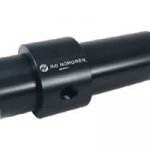Choosing the Right Pneumatic Cylinder: A Guide to Types, Applications, and Benefits
Choosing the right pneumatic cylinder is crucial for optimizing performance, efficiency, and safety in industrial applications. This guide will help you understand the different types of pneumatic cylinders, their applications, and benefits to make an informed decision with Air & Hydraulic Equipment!
Understanding Pneumatic Cylinders
A pneumatic cylinder, also known as an air cylinder, is a mechanical device that uses compressed air to produce linear motion and force. They are widely used in industries like manufacturing, packaging, and automation due to their simplicity, reliability, and cost-effectiveness.
Key Components:
- Cylinder Barrel: Houses the piston and guides its movement.
- Piston: Moves within the barrel to generate force.
- Piston Rod: Connects the piston to the machine component being moved.
- End Caps: Seal the ends of the cylinder and may include ports for air entry and exit.
Types of Pneumatic Cylinders
Understanding the various types of pneumatic cylinders is essential for selecting the right one for your application.
Single-Acting Cylinders
These cylinders use compressed air to move the piston in one direction, with a spring or external force returning it to the original position.
- Advantages: Simpler design and lower cost, reduced air consumption.
- Disadvantages: Limited to applications requiring force in one direction, spring return may not provide consistent force over time.
Double-Acting Cylinders
Compressed air is applied alternately to both sides of the piston, providing force in both extending and retracting directions.
- Advantages: Greater control and force in both directions, suitable for a wide range of applications.
- Disadvantages: More complex design and higher air consumption.
Telescopic Cylinders
Consist of multiple stages that extend sequentially, providing a longer stroke from a compact retracted length.
- Advantages: Ideal for applications with space constraints, provides extended reach.
- Disadvantages: More complex and potentially higher maintenance.
Rodless Cylinders
Feature a piston connected to an external carriage, allowing for motion without an extending rod.
- Advantages: Compact design saves space, suitable for long-stroke applications.
- Disadvantages: May have limitations in load capacity.
Explore our range of pneumatic cylinders to find the perfect fit for your application.
Applications of Pneumatic Cylinders
Pneumatic cylinders are versatile and used across various industries:
- Manufacturing: Automating assembly lines, pressing, and clamping operations.
- Packaging: Controlling movement in packaging machinery.
- Automotive: Operating robotic arms and material handling systems.
- Food and Beverage: Ensuring hygienic and efficient processing.
- Pharmaceutical: Precise control in filling and packaging processes.
Benefits of Using Pneumatic Cylinders
Pneumatic cylinders offer several advantages:
- Simplicity: Easy to install and maintain.
- Safety: Lower risk compared to hydraulic systems due to the use of air.
- Cost-Effectiveness: Generally more affordable than hydraulic or electric actuators.
- Clean Operation: Ideal for industries requiring contamination-free environments.
- Speed: Capable of rapid movement, enhancing productivity.
Partnering with Air & Hydraulic Equipment
With over 54 years of experience, Air & Hydraulic Equipment is your trusted source for high-quality pneumatic cylinders and automation solutions. Our team of experts is dedicated to helping you select the right components to optimize your systems.
Why Choose Us:
- Extensive product range from leading manufacturers.
- Customized solutions tailored to your needs.
- Exceptional customer service and technical support.
Contact us at Air & Hydraulic Equipment today to find the perfect pneumatic cylinder for your application!









